Managerial Economics: Economies of Scale and Scope in Airlines
VerifiedAdded on 2023/06/15
|19
|5124
|253
Case Study
AI Summary
This case study delves into the application of managerial economics within the airline industry, examining key concepts such as economies of scale and scope, the impact of mergers, and the advantages and disadvantages of the hub and spoke networking system. It investigates how economies of scale arise from factors like using a single type of plane and volume discounts, while economies of scope are achieved through carrying passengers and freight in the same aircraft and implementing hub and spoke routing. The analysis also addresses the potential diseconomies of scale due to overcrowding and delays. The study further explores the strategic implications of airline mergers, highlighting their effects on airfares and competition, and contrasting the hub-and-spoke system with point-to-point systems, emphasizing the trade-offs in travel time, cost, and complexity. This student contributed assignment is available on Desklib, where students can find a wide array of solved assignments and study resources.
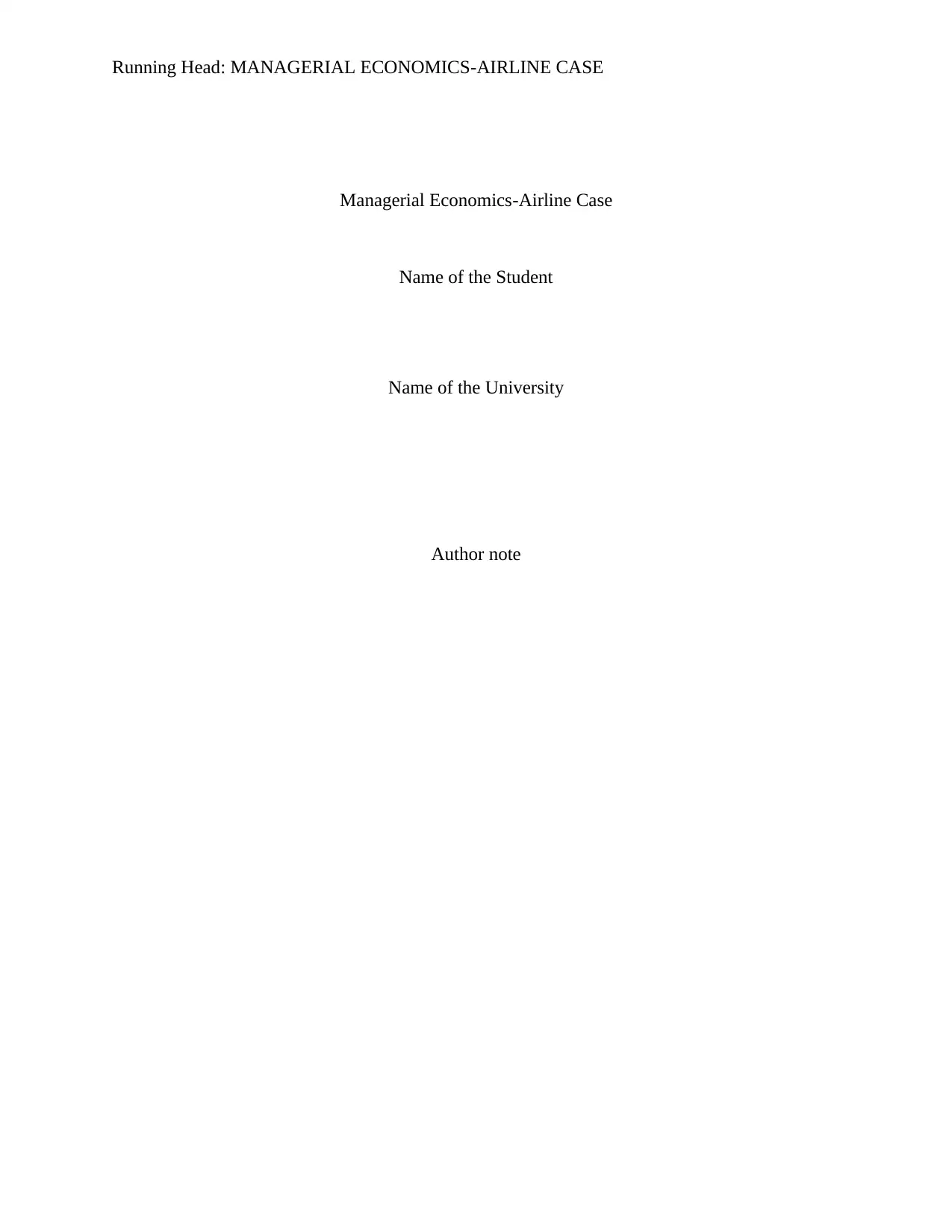
Running Head: MANAGERIAL ECONOMICS-AIRLINE CASE
Managerial Economics-Airline Case
Name of the Student
Name of the University
Author note
Managerial Economics-Airline Case
Name of the Student
Name of the University
Author note
Paraphrase This Document
Need a fresh take? Get an instant paraphrase of this document with our AI Paraphraser
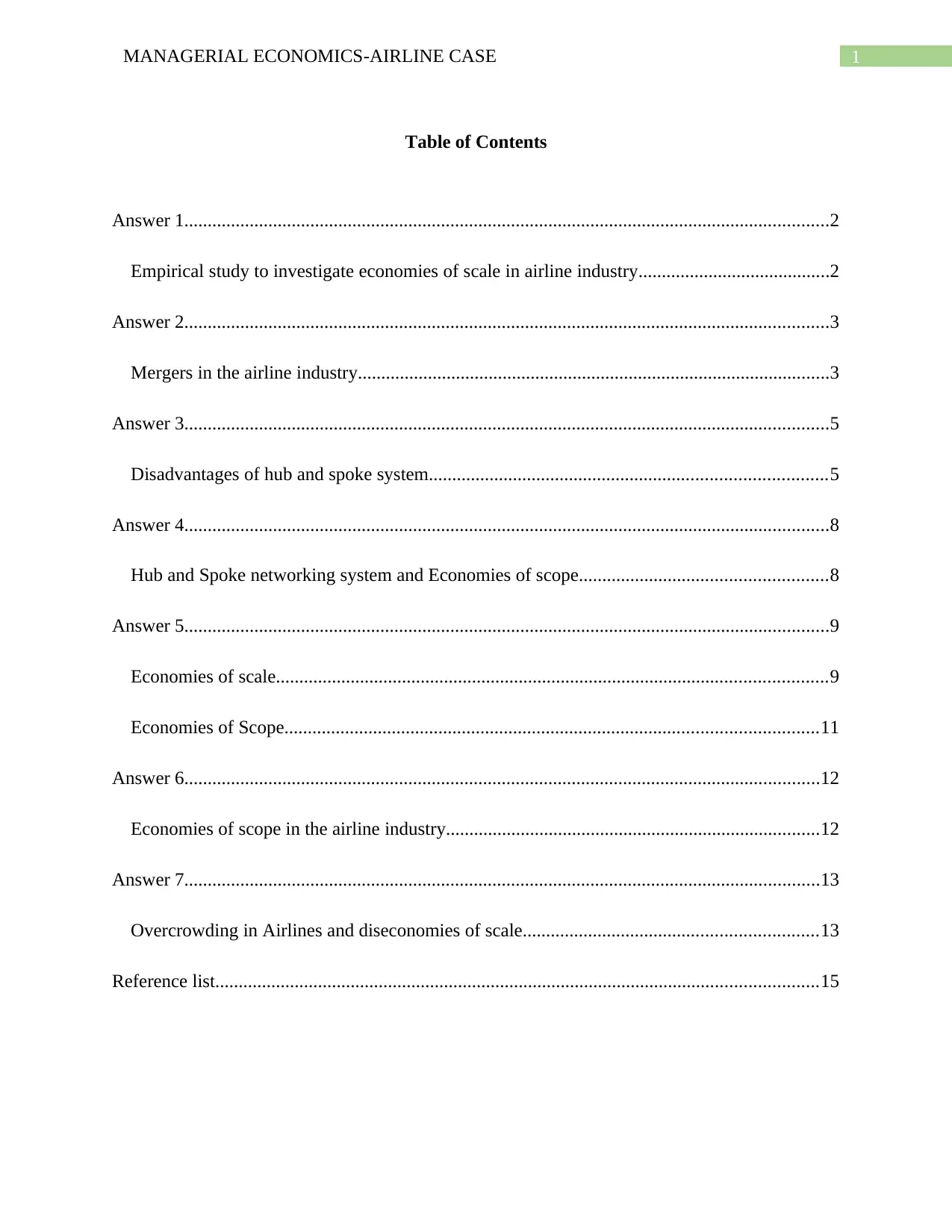
1MANAGERIAL ECONOMICS-AIRLINE CASE
Table of Contents
Answer 1..........................................................................................................................................2
Empirical study to investigate economies of scale in airline industry.........................................2
Answer 2..........................................................................................................................................3
Mergers in the airline industry.....................................................................................................3
Answer 3..........................................................................................................................................5
Disadvantages of hub and spoke system.....................................................................................5
Answer 4..........................................................................................................................................8
Hub and Spoke networking system and Economies of scope.....................................................8
Answer 5..........................................................................................................................................9
Economies of scale......................................................................................................................9
Economies of Scope..................................................................................................................11
Answer 6........................................................................................................................................12
Economies of scope in the airline industry................................................................................12
Answer 7........................................................................................................................................13
Overcrowding in Airlines and diseconomies of scale...............................................................13
Reference list.................................................................................................................................15
Table of Contents
Answer 1..........................................................................................................................................2
Empirical study to investigate economies of scale in airline industry.........................................2
Answer 2..........................................................................................................................................3
Mergers in the airline industry.....................................................................................................3
Answer 3..........................................................................................................................................5
Disadvantages of hub and spoke system.....................................................................................5
Answer 4..........................................................................................................................................8
Hub and Spoke networking system and Economies of scope.....................................................8
Answer 5..........................................................................................................................................9
Economies of scale......................................................................................................................9
Economies of Scope..................................................................................................................11
Answer 6........................................................................................................................................12
Economies of scope in the airline industry................................................................................12
Answer 7........................................................................................................................................13
Overcrowding in Airlines and diseconomies of scale...............................................................13
Reference list.................................................................................................................................15
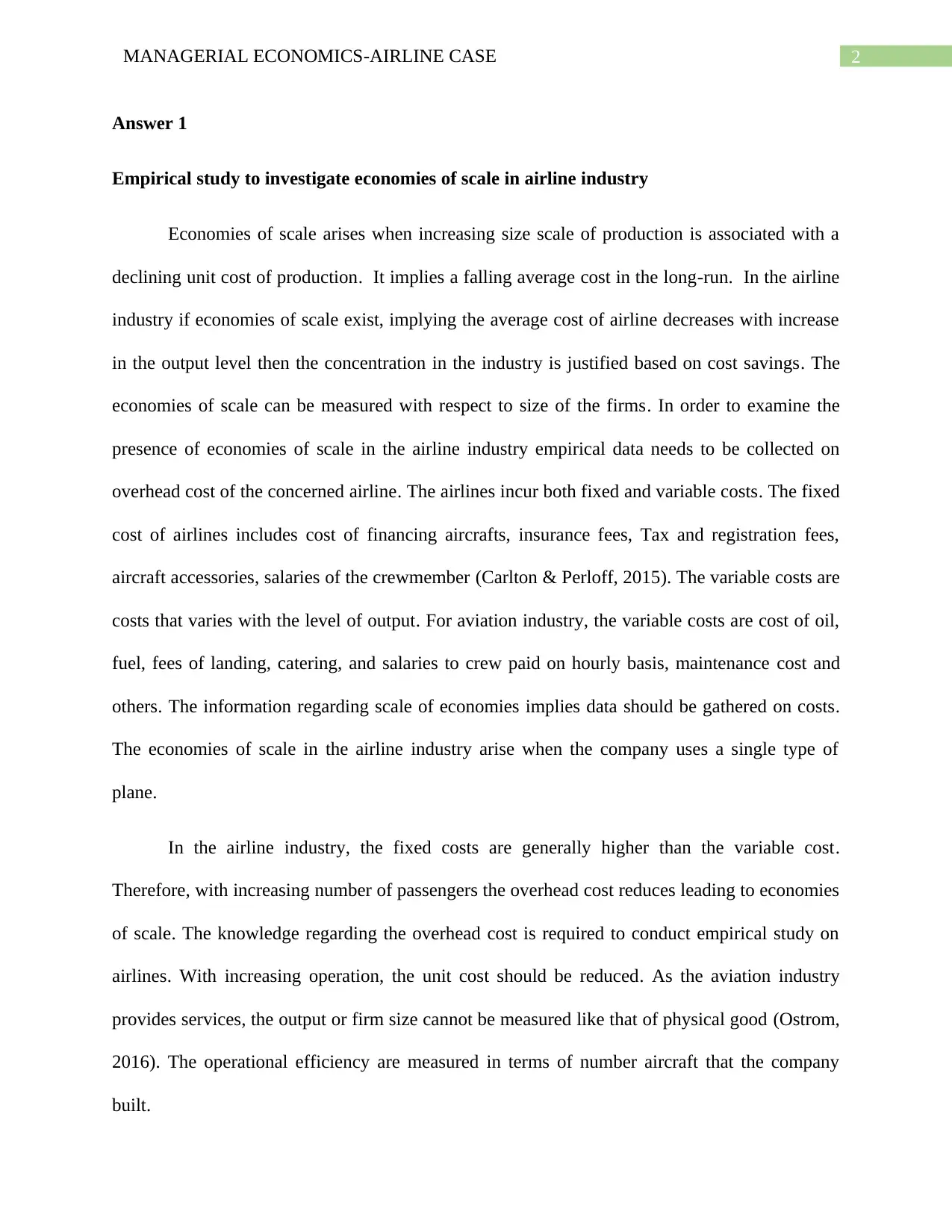
2MANAGERIAL ECONOMICS-AIRLINE CASE
Answer 1
Empirical study to investigate economies of scale in airline industry
Economies of scale arises when increasing size scale of production is associated with a
declining unit cost of production. It implies a falling average cost in the long-run. In the airline
industry if economies of scale exist, implying the average cost of airline decreases with increase
in the output level then the concentration in the industry is justified based on cost savings. The
economies of scale can be measured with respect to size of the firms. In order to examine the
presence of economies of scale in the airline industry empirical data needs to be collected on
overhead cost of the concerned airline. The airlines incur both fixed and variable costs. The fixed
cost of airlines includes cost of financing aircrafts, insurance fees, Tax and registration fees,
aircraft accessories, salaries of the crewmember (Carlton & Perloff, 2015). The variable costs are
costs that varies with the level of output. For aviation industry, the variable costs are cost of oil,
fuel, fees of landing, catering, and salaries to crew paid on hourly basis, maintenance cost and
others. The information regarding scale of economies implies data should be gathered on costs.
The economies of scale in the airline industry arise when the company uses a single type of
plane.
In the airline industry, the fixed costs are generally higher than the variable cost.
Therefore, with increasing number of passengers the overhead cost reduces leading to economies
of scale. The knowledge regarding the overhead cost is required to conduct empirical study on
airlines. With increasing operation, the unit cost should be reduced. As the aviation industry
provides services, the output or firm size cannot be measured like that of physical good (Ostrom,
2016). The operational efficiency are measured in terms of number aircraft that the company
built.
Answer 1
Empirical study to investigate economies of scale in airline industry
Economies of scale arises when increasing size scale of production is associated with a
declining unit cost of production. It implies a falling average cost in the long-run. In the airline
industry if economies of scale exist, implying the average cost of airline decreases with increase
in the output level then the concentration in the industry is justified based on cost savings. The
economies of scale can be measured with respect to size of the firms. In order to examine the
presence of economies of scale in the airline industry empirical data needs to be collected on
overhead cost of the concerned airline. The airlines incur both fixed and variable costs. The fixed
cost of airlines includes cost of financing aircrafts, insurance fees, Tax and registration fees,
aircraft accessories, salaries of the crewmember (Carlton & Perloff, 2015). The variable costs are
costs that varies with the level of output. For aviation industry, the variable costs are cost of oil,
fuel, fees of landing, catering, and salaries to crew paid on hourly basis, maintenance cost and
others. The information regarding scale of economies implies data should be gathered on costs.
The economies of scale in the airline industry arise when the company uses a single type of
plane.
In the airline industry, the fixed costs are generally higher than the variable cost.
Therefore, with increasing number of passengers the overhead cost reduces leading to economies
of scale. The knowledge regarding the overhead cost is required to conduct empirical study on
airlines. With increasing operation, the unit cost should be reduced. As the aviation industry
provides services, the output or firm size cannot be measured like that of physical good (Ostrom,
2016). The operational efficiency are measured in terms of number aircraft that the company
built.
⊘ This is a preview!⊘
Do you want full access?
Subscribe today to unlock all pages.

Trusted by 1+ million students worldwide
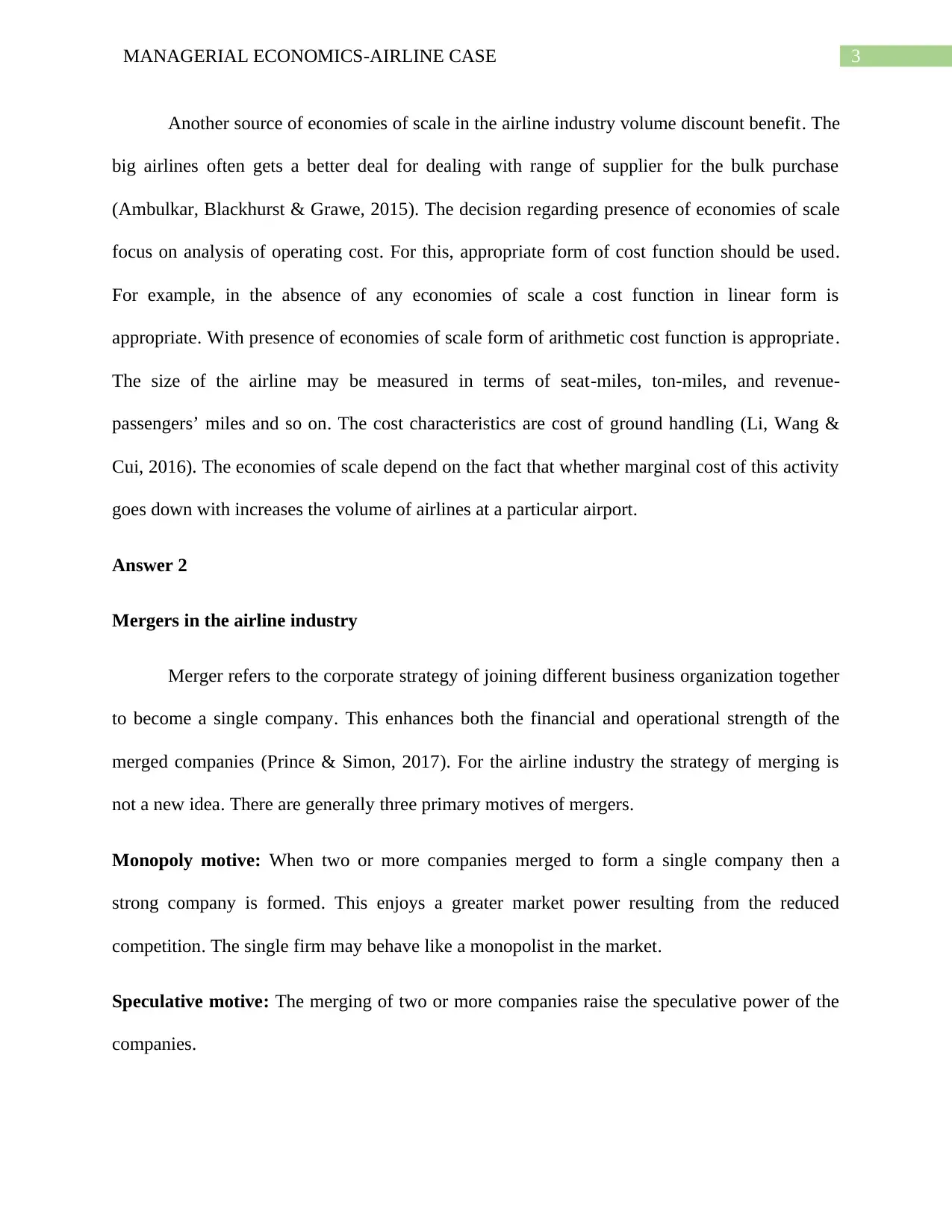
3MANAGERIAL ECONOMICS-AIRLINE CASE
Another source of economies of scale in the airline industry volume discount benefit. The
big airlines often gets a better deal for dealing with range of supplier for the bulk purchase
(Ambulkar, Blackhurst & Grawe, 2015). The decision regarding presence of economies of scale
focus on analysis of operating cost. For this, appropriate form of cost function should be used.
For example, in the absence of any economies of scale a cost function in linear form is
appropriate. With presence of economies of scale form of arithmetic cost function is appropriate.
The size of the airline may be measured in terms of seat-miles, ton-miles, and revenue-
passengers’ miles and so on. The cost characteristics are cost of ground handling (Li, Wang &
Cui, 2016). The economies of scale depend on the fact that whether marginal cost of this activity
goes down with increases the volume of airlines at a particular airport.
Answer 2
Mergers in the airline industry
Merger refers to the corporate strategy of joining different business organization together
to become a single company. This enhances both the financial and operational strength of the
merged companies (Prince & Simon, 2017). For the airline industry the strategy of merging is
not a new idea. There are generally three primary motives of mergers.
Monopoly motive: When two or more companies merged to form a single company then a
strong company is formed. This enjoys a greater market power resulting from the reduced
competition. The single firm may behave like a monopolist in the market.
Speculative motive: The merging of two or more companies raise the speculative power of the
companies.
Another source of economies of scale in the airline industry volume discount benefit. The
big airlines often gets a better deal for dealing with range of supplier for the bulk purchase
(Ambulkar, Blackhurst & Grawe, 2015). The decision regarding presence of economies of scale
focus on analysis of operating cost. For this, appropriate form of cost function should be used.
For example, in the absence of any economies of scale a cost function in linear form is
appropriate. With presence of economies of scale form of arithmetic cost function is appropriate.
The size of the airline may be measured in terms of seat-miles, ton-miles, and revenue-
passengers’ miles and so on. The cost characteristics are cost of ground handling (Li, Wang &
Cui, 2016). The economies of scale depend on the fact that whether marginal cost of this activity
goes down with increases the volume of airlines at a particular airport.
Answer 2
Mergers in the airline industry
Merger refers to the corporate strategy of joining different business organization together
to become a single company. This enhances both the financial and operational strength of the
merged companies (Prince & Simon, 2017). For the airline industry the strategy of merging is
not a new idea. There are generally three primary motives of mergers.
Monopoly motive: When two or more companies merged to form a single company then a
strong company is formed. This enjoys a greater market power resulting from the reduced
competition. The single firm may behave like a monopolist in the market.
Speculative motive: The merging of two or more companies raise the speculative power of the
companies.
Paraphrase This Document
Need a fresh take? Get an instant paraphrase of this document with our AI Paraphraser
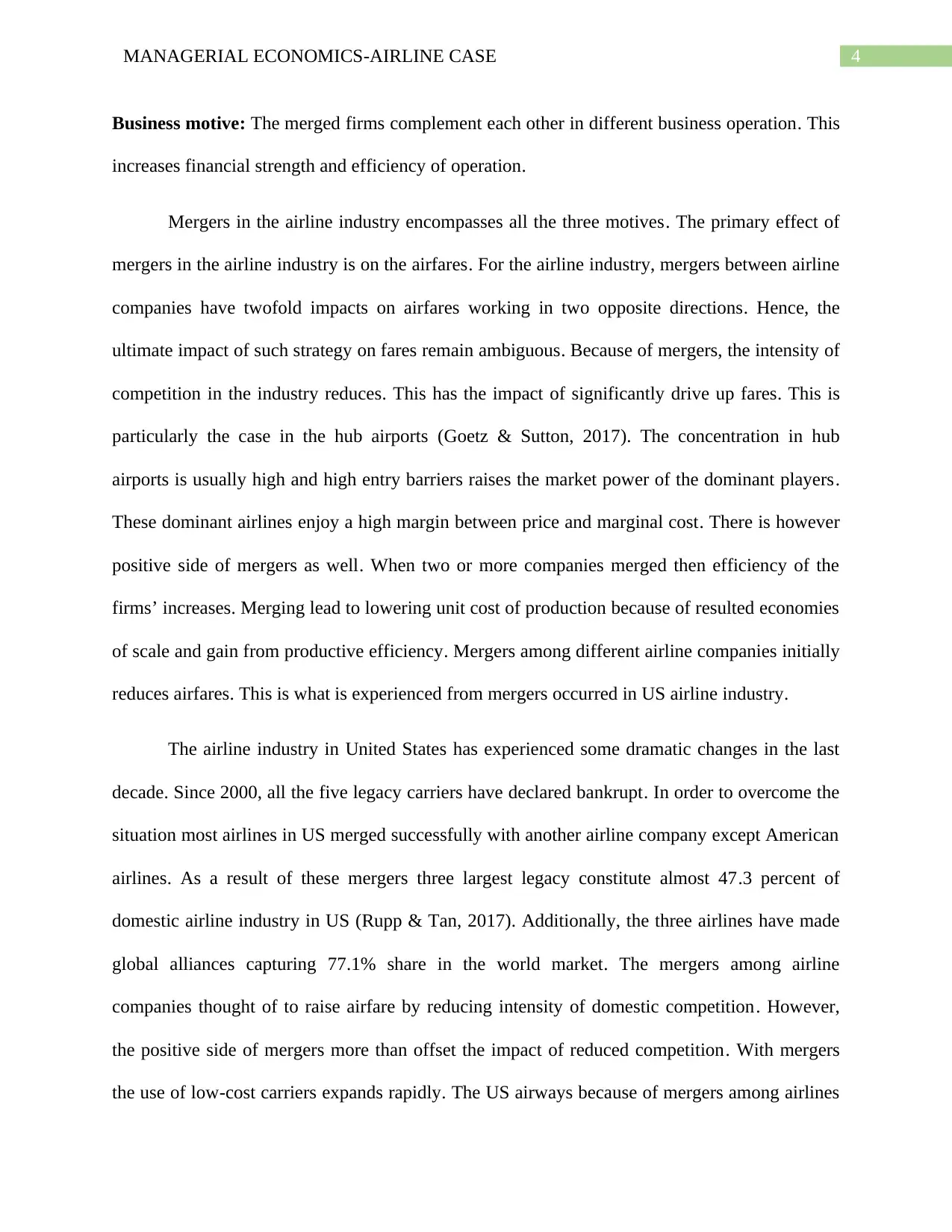
4MANAGERIAL ECONOMICS-AIRLINE CASE
Business motive: The merged firms complement each other in different business operation. This
increases financial strength and efficiency of operation.
Mergers in the airline industry encompasses all the three motives. The primary effect of
mergers in the airline industry is on the airfares. For the airline industry, mergers between airline
companies have twofold impacts on airfares working in two opposite directions. Hence, the
ultimate impact of such strategy on fares remain ambiguous. Because of mergers, the intensity of
competition in the industry reduces. This has the impact of significantly drive up fares. This is
particularly the case in the hub airports (Goetz & Sutton, 2017). The concentration in hub
airports is usually high and high entry barriers raises the market power of the dominant players.
These dominant airlines enjoy a high margin between price and marginal cost. There is however
positive side of mergers as well. When two or more companies merged then efficiency of the
firms’ increases. Merging lead to lowering unit cost of production because of resulted economies
of scale and gain from productive efficiency. Mergers among different airline companies initially
reduces airfares. This is what is experienced from mergers occurred in US airline industry.
The airline industry in United States has experienced some dramatic changes in the last
decade. Since 2000, all the five legacy carriers have declared bankrupt. In order to overcome the
situation most airlines in US merged successfully with another airline company except American
airlines. As a result of these mergers three largest legacy constitute almost 47.3 percent of
domestic airline industry in US (Rupp & Tan, 2017). Additionally, the three airlines have made
global alliances capturing 77.1% share in the world market. The mergers among airline
companies thought of to raise airfare by reducing intensity of domestic competition. However,
the positive side of mergers more than offset the impact of reduced competition. With mergers
the use of low-cost carriers expands rapidly. The US airways because of mergers among airlines
Business motive: The merged firms complement each other in different business operation. This
increases financial strength and efficiency of operation.
Mergers in the airline industry encompasses all the three motives. The primary effect of
mergers in the airline industry is on the airfares. For the airline industry, mergers between airline
companies have twofold impacts on airfares working in two opposite directions. Hence, the
ultimate impact of such strategy on fares remain ambiguous. Because of mergers, the intensity of
competition in the industry reduces. This has the impact of significantly drive up fares. This is
particularly the case in the hub airports (Goetz & Sutton, 2017). The concentration in hub
airports is usually high and high entry barriers raises the market power of the dominant players.
These dominant airlines enjoy a high margin between price and marginal cost. There is however
positive side of mergers as well. When two or more companies merged then efficiency of the
firms’ increases. Merging lead to lowering unit cost of production because of resulted economies
of scale and gain from productive efficiency. Mergers among different airline companies initially
reduces airfares. This is what is experienced from mergers occurred in US airline industry.
The airline industry in United States has experienced some dramatic changes in the last
decade. Since 2000, all the five legacy carriers have declared bankrupt. In order to overcome the
situation most airlines in US merged successfully with another airline company except American
airlines. As a result of these mergers three largest legacy constitute almost 47.3 percent of
domestic airline industry in US (Rupp & Tan, 2017). Additionally, the three airlines have made
global alliances capturing 77.1% share in the world market. The mergers among airline
companies thought of to raise airfare by reducing intensity of domestic competition. However,
the positive side of mergers more than offset the impact of reduced competition. With mergers
the use of low-cost carriers expands rapidly. The US airways because of mergers among airlines
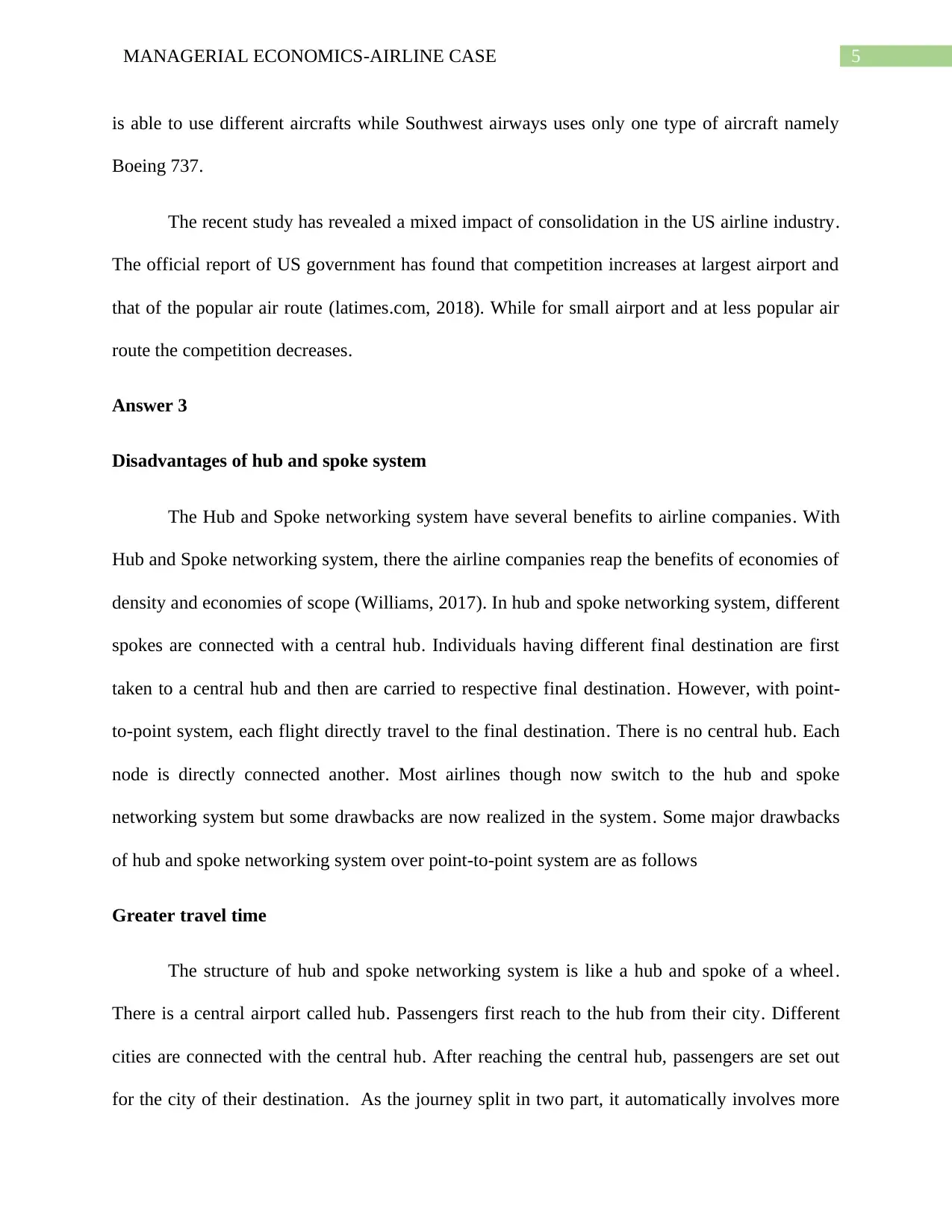
5MANAGERIAL ECONOMICS-AIRLINE CASE
is able to use different aircrafts while Southwest airways uses only one type of aircraft namely
Boeing 737.
The recent study has revealed a mixed impact of consolidation in the US airline industry.
The official report of US government has found that competition increases at largest airport and
that of the popular air route (latimes.com, 2018). While for small airport and at less popular air
route the competition decreases.
Answer 3
Disadvantages of hub and spoke system
The Hub and Spoke networking system have several benefits to airline companies. With
Hub and Spoke networking system, there the airline companies reap the benefits of economies of
density and economies of scope (Williams, 2017). In hub and spoke networking system, different
spokes are connected with a central hub. Individuals having different final destination are first
taken to a central hub and then are carried to respective final destination. However, with point-
to-point system, each flight directly travel to the final destination. There is no central hub. Each
node is directly connected another. Most airlines though now switch to the hub and spoke
networking system but some drawbacks are now realized in the system. Some major drawbacks
of hub and spoke networking system over point-to-point system are as follows
Greater travel time
The structure of hub and spoke networking system is like a hub and spoke of a wheel.
There is a central airport called hub. Passengers first reach to the hub from their city. Different
cities are connected with the central hub. After reaching the central hub, passengers are set out
for the city of their destination. As the journey split in two part, it automatically involves more
is able to use different aircrafts while Southwest airways uses only one type of aircraft namely
Boeing 737.
The recent study has revealed a mixed impact of consolidation in the US airline industry.
The official report of US government has found that competition increases at largest airport and
that of the popular air route (latimes.com, 2018). While for small airport and at less popular air
route the competition decreases.
Answer 3
Disadvantages of hub and spoke system
The Hub and Spoke networking system have several benefits to airline companies. With
Hub and Spoke networking system, there the airline companies reap the benefits of economies of
density and economies of scope (Williams, 2017). In hub and spoke networking system, different
spokes are connected with a central hub. Individuals having different final destination are first
taken to a central hub and then are carried to respective final destination. However, with point-
to-point system, each flight directly travel to the final destination. There is no central hub. Each
node is directly connected another. Most airlines though now switch to the hub and spoke
networking system but some drawbacks are now realized in the system. Some major drawbacks
of hub and spoke networking system over point-to-point system are as follows
Greater travel time
The structure of hub and spoke networking system is like a hub and spoke of a wheel.
There is a central airport called hub. Passengers first reach to the hub from their city. Different
cities are connected with the central hub. After reaching the central hub, passengers are set out
for the city of their destination. As the journey split in two part, it automatically involves more
⊘ This is a preview!⊘
Do you want full access?
Subscribe today to unlock all pages.

Trusted by 1+ million students worldwide
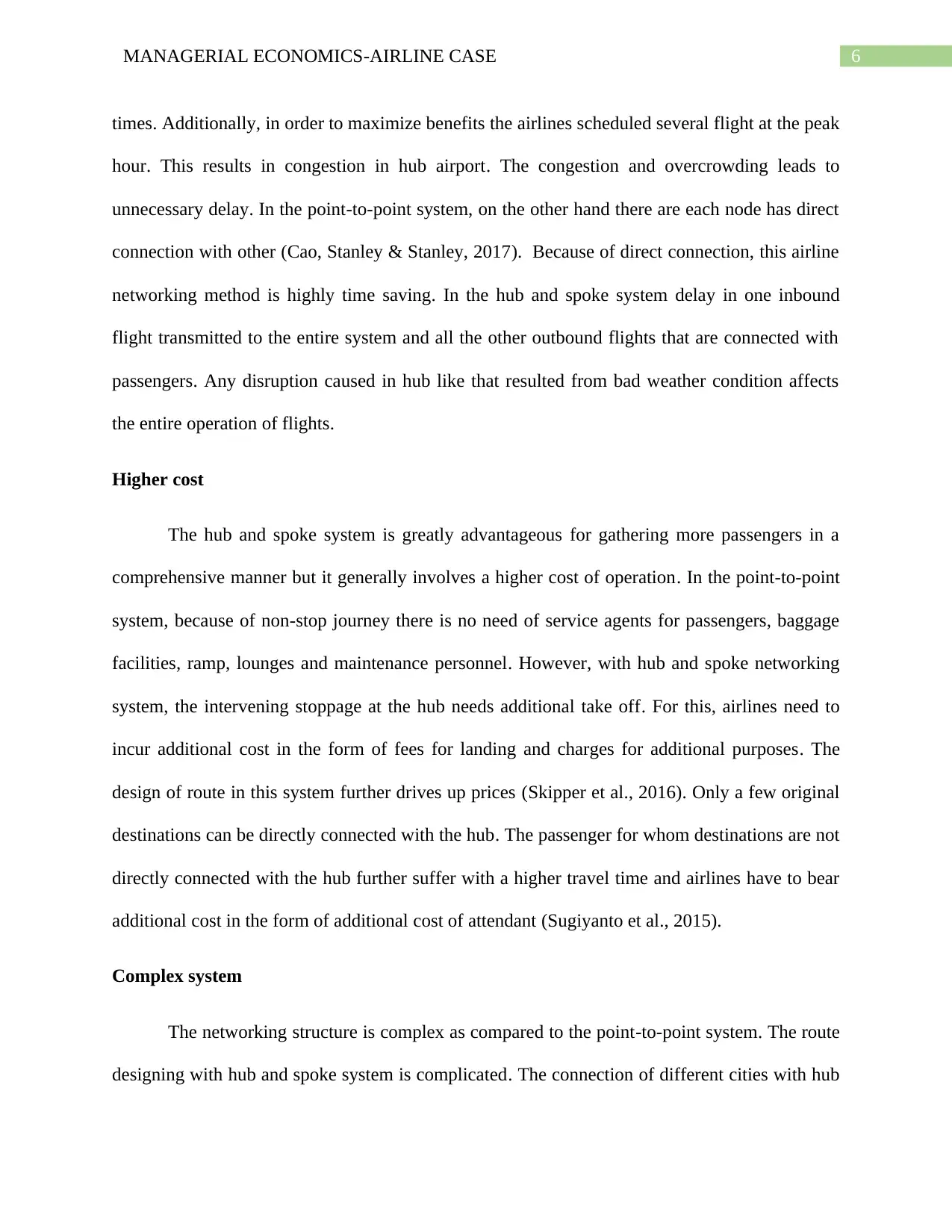
6MANAGERIAL ECONOMICS-AIRLINE CASE
times. Additionally, in order to maximize benefits the airlines scheduled several flight at the peak
hour. This results in congestion in hub airport. The congestion and overcrowding leads to
unnecessary delay. In the point-to-point system, on the other hand there are each node has direct
connection with other (Cao, Stanley & Stanley, 2017). Because of direct connection, this airline
networking method is highly time saving. In the hub and spoke system delay in one inbound
flight transmitted to the entire system and all the other outbound flights that are connected with
passengers. Any disruption caused in hub like that resulted from bad weather condition affects
the entire operation of flights.
Higher cost
The hub and spoke system is greatly advantageous for gathering more passengers in a
comprehensive manner but it generally involves a higher cost of operation. In the point-to-point
system, because of non-stop journey there is no need of service agents for passengers, baggage
facilities, ramp, lounges and maintenance personnel. However, with hub and spoke networking
system, the intervening stoppage at the hub needs additional take off. For this, airlines need to
incur additional cost in the form of fees for landing and charges for additional purposes. The
design of route in this system further drives up prices (Skipper et al., 2016). Only a few original
destinations can be directly connected with the hub. The passenger for whom destinations are not
directly connected with the hub further suffer with a higher travel time and airlines have to bear
additional cost in the form of additional cost of attendant (Sugiyanto et al., 2015).
Complex system
The networking structure is complex as compared to the point-to-point system. The route
designing with hub and spoke system is complicated. The connection of different cities with hub
times. Additionally, in order to maximize benefits the airlines scheduled several flight at the peak
hour. This results in congestion in hub airport. The congestion and overcrowding leads to
unnecessary delay. In the point-to-point system, on the other hand there are each node has direct
connection with other (Cao, Stanley & Stanley, 2017). Because of direct connection, this airline
networking method is highly time saving. In the hub and spoke system delay in one inbound
flight transmitted to the entire system and all the other outbound flights that are connected with
passengers. Any disruption caused in hub like that resulted from bad weather condition affects
the entire operation of flights.
Higher cost
The hub and spoke system is greatly advantageous for gathering more passengers in a
comprehensive manner but it generally involves a higher cost of operation. In the point-to-point
system, because of non-stop journey there is no need of service agents for passengers, baggage
facilities, ramp, lounges and maintenance personnel. However, with hub and spoke networking
system, the intervening stoppage at the hub needs additional take off. For this, airlines need to
incur additional cost in the form of fees for landing and charges for additional purposes. The
design of route in this system further drives up prices (Skipper et al., 2016). Only a few original
destinations can be directly connected with the hub. The passenger for whom destinations are not
directly connected with the hub further suffer with a higher travel time and airlines have to bear
additional cost in the form of additional cost of attendant (Sugiyanto et al., 2015).
Complex system
The networking structure is complex as compared to the point-to-point system. The route
designing with hub and spoke system is complicated. The connection of different cities with hub
Paraphrase This Document
Need a fresh take? Get an instant paraphrase of this document with our AI Paraphraser
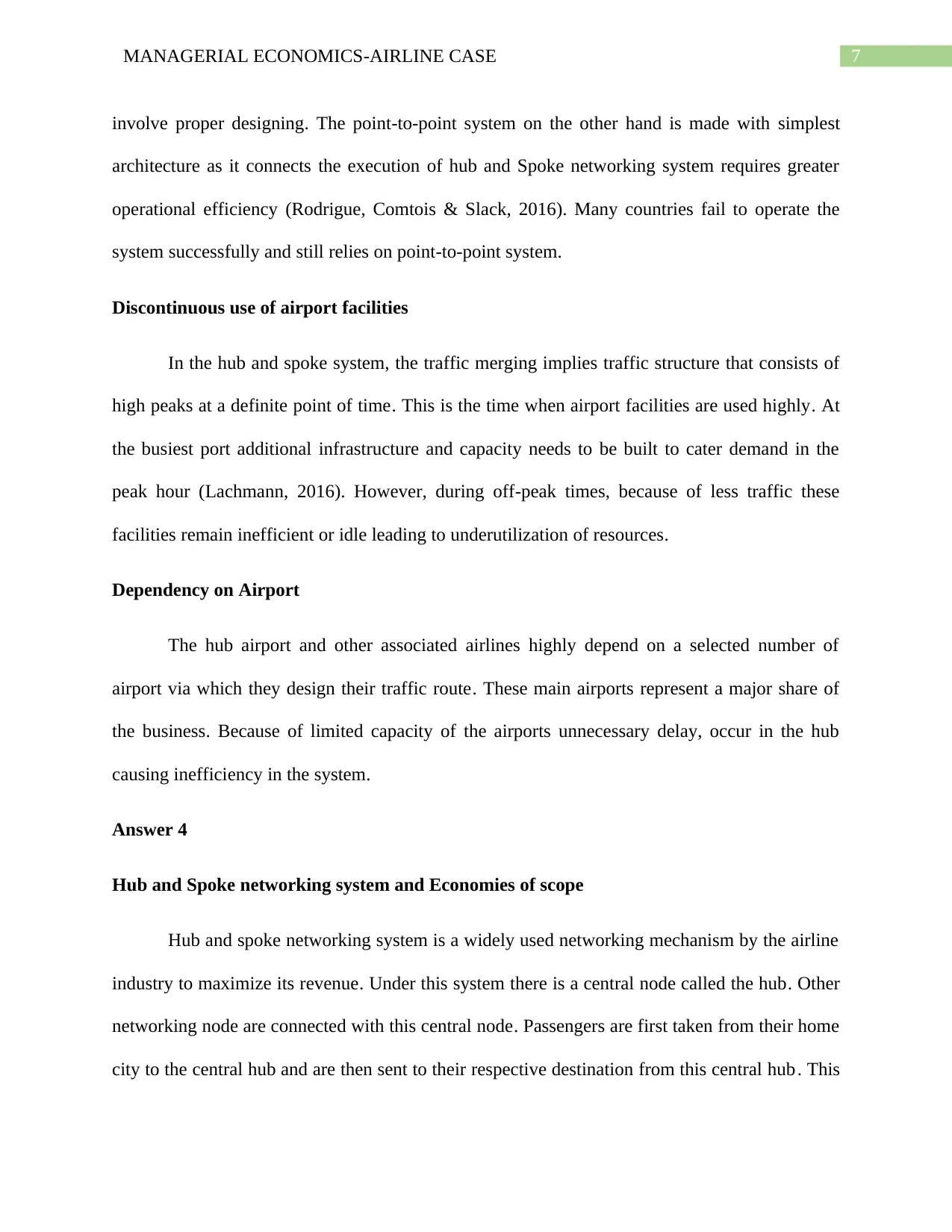
7MANAGERIAL ECONOMICS-AIRLINE CASE
involve proper designing. The point-to-point system on the other hand is made with simplest
architecture as it connects the execution of hub and Spoke networking system requires greater
operational efficiency (Rodrigue, Comtois & Slack, 2016). Many countries fail to operate the
system successfully and still relies on point-to-point system.
Discontinuous use of airport facilities
In the hub and spoke system, the traffic merging implies traffic structure that consists of
high peaks at a definite point of time. This is the time when airport facilities are used highly. At
the busiest port additional infrastructure and capacity needs to be built to cater demand in the
peak hour (Lachmann, 2016). However, during off-peak times, because of less traffic these
facilities remain inefficient or idle leading to underutilization of resources.
Dependency on Airport
The hub airport and other associated airlines highly depend on a selected number of
airport via which they design their traffic route. These main airports represent a major share of
the business. Because of limited capacity of the airports unnecessary delay, occur in the hub
causing inefficiency in the system.
Answer 4
Hub and Spoke networking system and Economies of scope
Hub and spoke networking system is a widely used networking mechanism by the airline
industry to maximize its revenue. Under this system there is a central node called the hub. Other
networking node are connected with this central node. Passengers are first taken from their home
city to the central hub and are then sent to their respective destination from this central hub . This
involve proper designing. The point-to-point system on the other hand is made with simplest
architecture as it connects the execution of hub and Spoke networking system requires greater
operational efficiency (Rodrigue, Comtois & Slack, 2016). Many countries fail to operate the
system successfully and still relies on point-to-point system.
Discontinuous use of airport facilities
In the hub and spoke system, the traffic merging implies traffic structure that consists of
high peaks at a definite point of time. This is the time when airport facilities are used highly. At
the busiest port additional infrastructure and capacity needs to be built to cater demand in the
peak hour (Lachmann, 2016). However, during off-peak times, because of less traffic these
facilities remain inefficient or idle leading to underutilization of resources.
Dependency on Airport
The hub airport and other associated airlines highly depend on a selected number of
airport via which they design their traffic route. These main airports represent a major share of
the business. Because of limited capacity of the airports unnecessary delay, occur in the hub
causing inefficiency in the system.
Answer 4
Hub and Spoke networking system and Economies of scope
Hub and spoke networking system is a widely used networking mechanism by the airline
industry to maximize its revenue. Under this system there is a central node called the hub. Other
networking node are connected with this central node. Passengers are first taken from their home
city to the central hub and are then sent to their respective destination from this central hub . This
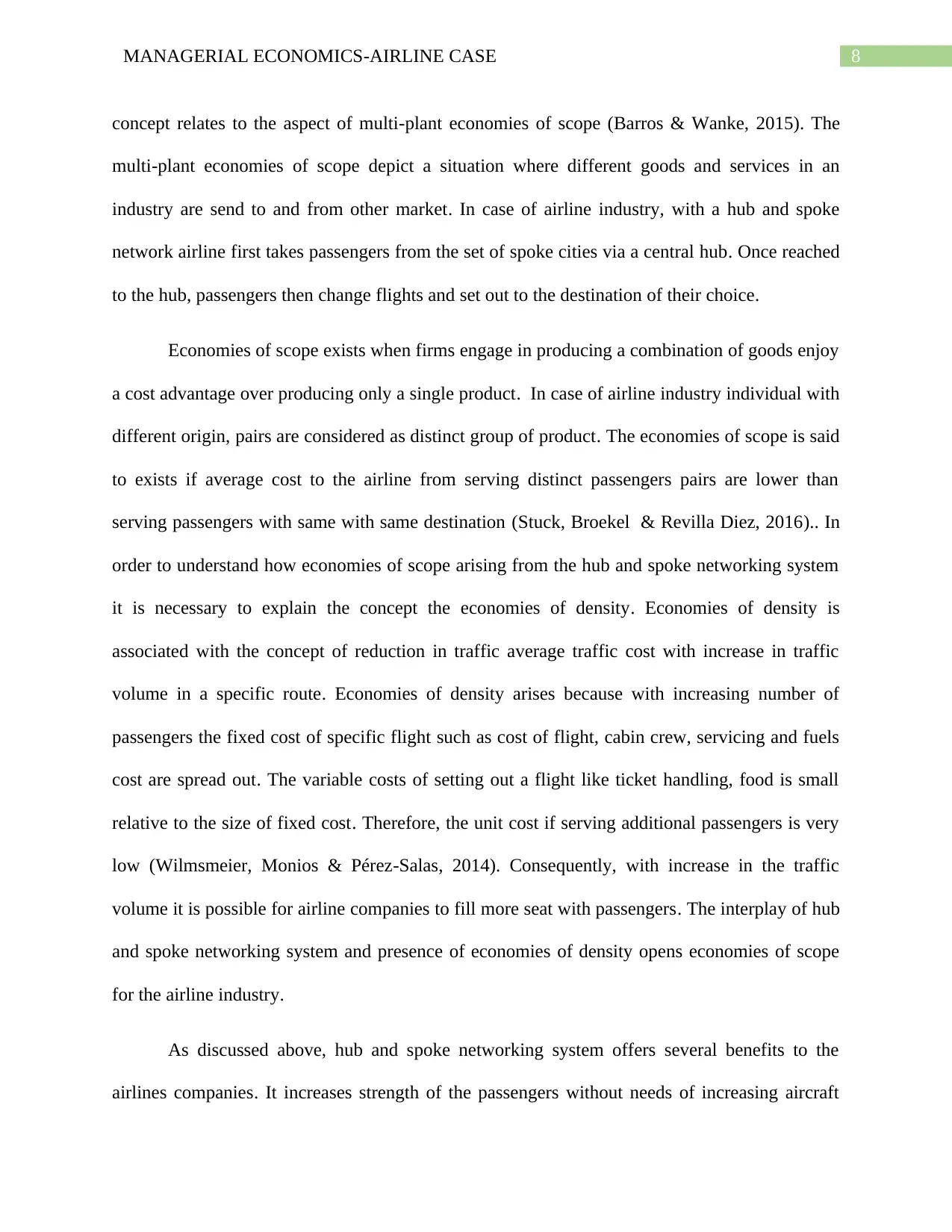
8MANAGERIAL ECONOMICS-AIRLINE CASE
concept relates to the aspect of multi-plant economies of scope (Barros & Wanke, 2015). The
multi-plant economies of scope depict a situation where different goods and services in an
industry are send to and from other market. In case of airline industry, with a hub and spoke
network airline first takes passengers from the set of spoke cities via a central hub. Once reached
to the hub, passengers then change flights and set out to the destination of their choice.
Economies of scope exists when firms engage in producing a combination of goods enjoy
a cost advantage over producing only a single product. In case of airline industry individual with
different origin, pairs are considered as distinct group of product. The economies of scope is said
to exists if average cost to the airline from serving distinct passengers pairs are lower than
serving passengers with same with same destination (Stuck, Broekel & Revilla Diez, 2016).. In
order to understand how economies of scope arising from the hub and spoke networking system
it is necessary to explain the concept the economies of density. Economies of density is
associated with the concept of reduction in traffic average traffic cost with increase in traffic
volume in a specific route. Economies of density arises because with increasing number of
passengers the fixed cost of specific flight such as cost of flight, cabin crew, servicing and fuels
cost are spread out. The variable costs of setting out a flight like ticket handling, food is small
relative to the size of fixed cost. Therefore, the unit cost if serving additional passengers is very
low (Wilmsmeier, Monios & Pérez-Salas, 2014). Consequently, with increase in the traffic
volume it is possible for airline companies to fill more seat with passengers. The interplay of hub
and spoke networking system and presence of economies of density opens economies of scope
for the airline industry.
As discussed above, hub and spoke networking system offers several benefits to the
airlines companies. It increases strength of the passengers without needs of increasing aircraft
concept relates to the aspect of multi-plant economies of scope (Barros & Wanke, 2015). The
multi-plant economies of scope depict a situation where different goods and services in an
industry are send to and from other market. In case of airline industry, with a hub and spoke
network airline first takes passengers from the set of spoke cities via a central hub. Once reached
to the hub, passengers then change flights and set out to the destination of their choice.
Economies of scope exists when firms engage in producing a combination of goods enjoy
a cost advantage over producing only a single product. In case of airline industry individual with
different origin, pairs are considered as distinct group of product. The economies of scope is said
to exists if average cost to the airline from serving distinct passengers pairs are lower than
serving passengers with same with same destination (Stuck, Broekel & Revilla Diez, 2016).. In
order to understand how economies of scope arising from the hub and spoke networking system
it is necessary to explain the concept the economies of density. Economies of density is
associated with the concept of reduction in traffic average traffic cost with increase in traffic
volume in a specific route. Economies of density arises because with increasing number of
passengers the fixed cost of specific flight such as cost of flight, cabin crew, servicing and fuels
cost are spread out. The variable costs of setting out a flight like ticket handling, food is small
relative to the size of fixed cost. Therefore, the unit cost if serving additional passengers is very
low (Wilmsmeier, Monios & Pérez-Salas, 2014). Consequently, with increase in the traffic
volume it is possible for airline companies to fill more seat with passengers. The interplay of hub
and spoke networking system and presence of economies of density opens economies of scope
for the airline industry.
As discussed above, hub and spoke networking system offers several benefits to the
airlines companies. It increases strength of the passengers without needs of increasing aircraft
⊘ This is a preview!⊘
Do you want full access?
Subscribe today to unlock all pages.

Trusted by 1+ million students worldwide
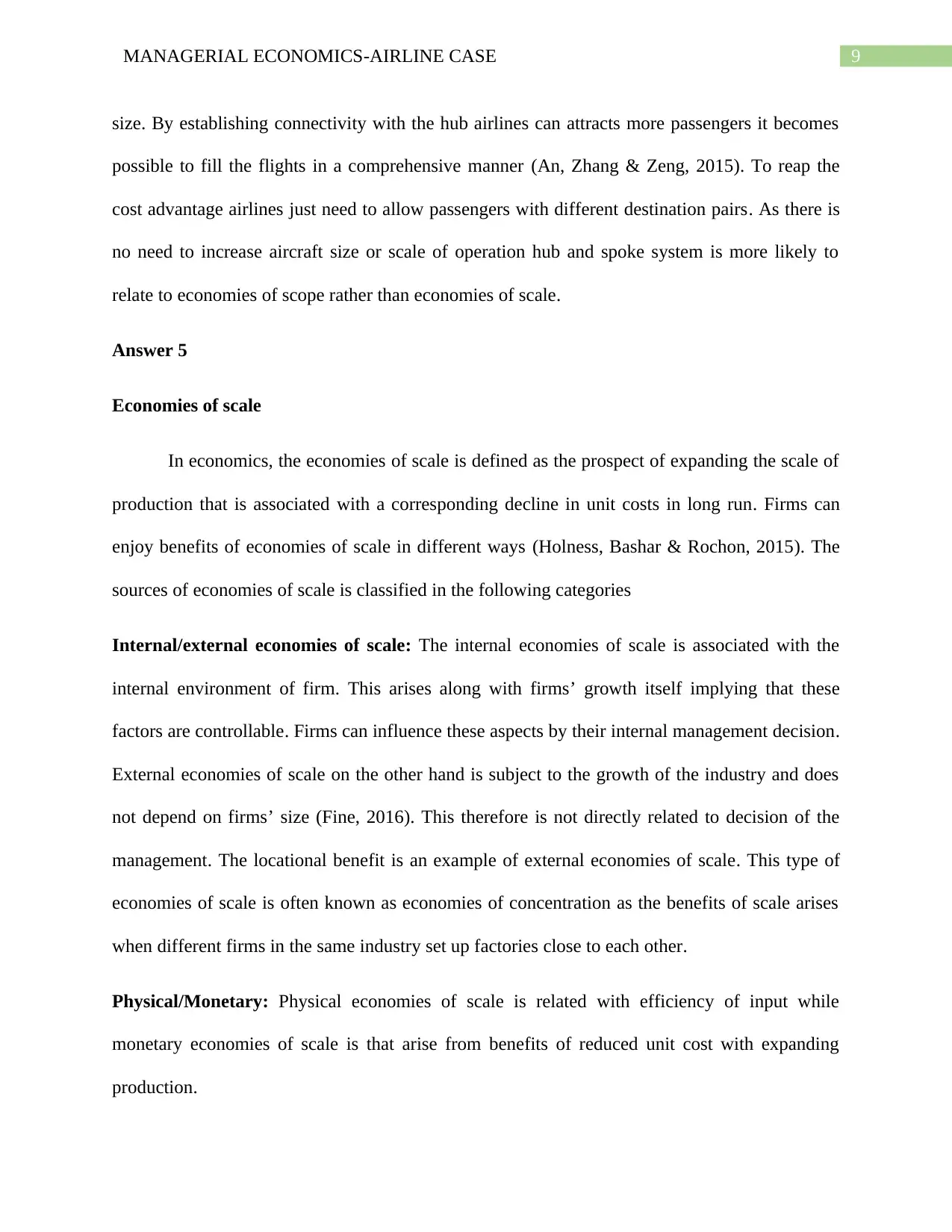
9MANAGERIAL ECONOMICS-AIRLINE CASE
size. By establishing connectivity with the hub airlines can attracts more passengers it becomes
possible to fill the flights in a comprehensive manner (An, Zhang & Zeng, 2015). To reap the
cost advantage airlines just need to allow passengers with different destination pairs. As there is
no need to increase aircraft size or scale of operation hub and spoke system is more likely to
relate to economies of scope rather than economies of scale.
Answer 5
Economies of scale
In economics, the economies of scale is defined as the prospect of expanding the scale of
production that is associated with a corresponding decline in unit costs in long run. Firms can
enjoy benefits of economies of scale in different ways (Holness, Bashar & Rochon, 2015). The
sources of economies of scale is classified in the following categories
Internal/external economies of scale: The internal economies of scale is associated with the
internal environment of firm. This arises along with firms’ growth itself implying that these
factors are controllable. Firms can influence these aspects by their internal management decision.
External economies of scale on the other hand is subject to the growth of the industry and does
not depend on firms’ size (Fine, 2016). This therefore is not directly related to decision of the
management. The locational benefit is an example of external economies of scale. This type of
economies of scale is often known as economies of concentration as the benefits of scale arises
when different firms in the same industry set up factories close to each other.
Physical/Monetary: Physical economies of scale is related with efficiency of input while
monetary economies of scale is that arise from benefits of reduced unit cost with expanding
production.
size. By establishing connectivity with the hub airlines can attracts more passengers it becomes
possible to fill the flights in a comprehensive manner (An, Zhang & Zeng, 2015). To reap the
cost advantage airlines just need to allow passengers with different destination pairs. As there is
no need to increase aircraft size or scale of operation hub and spoke system is more likely to
relate to economies of scope rather than economies of scale.
Answer 5
Economies of scale
In economics, the economies of scale is defined as the prospect of expanding the scale of
production that is associated with a corresponding decline in unit costs in long run. Firms can
enjoy benefits of economies of scale in different ways (Holness, Bashar & Rochon, 2015). The
sources of economies of scale is classified in the following categories
Internal/external economies of scale: The internal economies of scale is associated with the
internal environment of firm. This arises along with firms’ growth itself implying that these
factors are controllable. Firms can influence these aspects by their internal management decision.
External economies of scale on the other hand is subject to the growth of the industry and does
not depend on firms’ size (Fine, 2016). This therefore is not directly related to decision of the
management. The locational benefit is an example of external economies of scale. This type of
economies of scale is often known as economies of concentration as the benefits of scale arises
when different firms in the same industry set up factories close to each other.
Physical/Monetary: Physical economies of scale is related with efficiency of input while
monetary economies of scale is that arise from benefits of reduced unit cost with expanding
production.
Paraphrase This Document
Need a fresh take? Get an instant paraphrase of this document with our AI Paraphraser
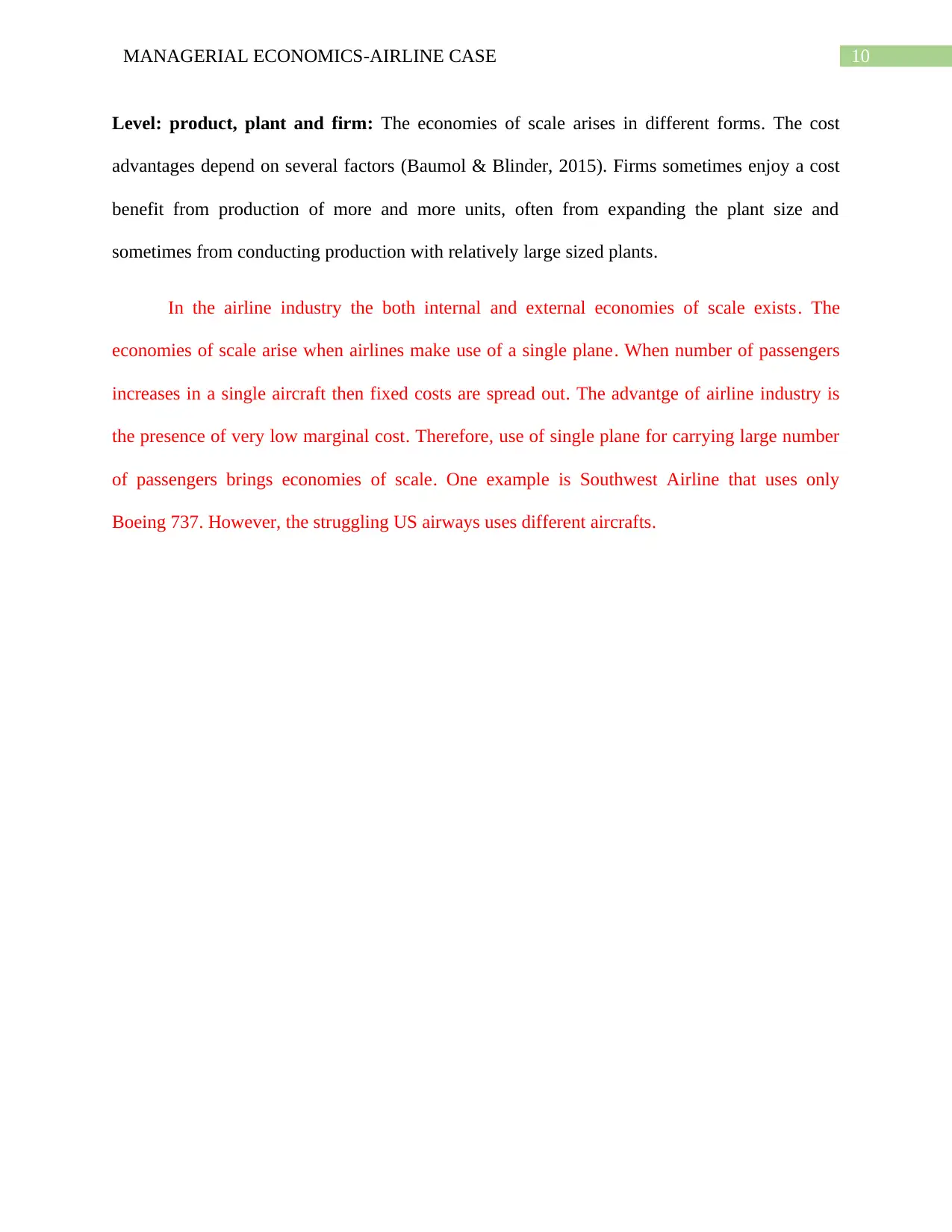
10MANAGERIAL ECONOMICS-AIRLINE CASE
Level: product, plant and firm: The economies of scale arises in different forms. The cost
advantages depend on several factors (Baumol & Blinder, 2015). Firms sometimes enjoy a cost
benefit from production of more and more units, often from expanding the plant size and
sometimes from conducting production with relatively large sized plants.
In the airline industry the both internal and external economies of scale exists. The
economies of scale arise when airlines make use of a single plane. When number of passengers
increases in a single aircraft then fixed costs are spread out. The advantge of airline industry is
the presence of very low marginal cost. Therefore, use of single plane for carrying large number
of passengers brings economies of scale. One example is Southwest Airline that uses only
Boeing 737. However, the struggling US airways uses different aircrafts.
Level: product, plant and firm: The economies of scale arises in different forms. The cost
advantages depend on several factors (Baumol & Blinder, 2015). Firms sometimes enjoy a cost
benefit from production of more and more units, often from expanding the plant size and
sometimes from conducting production with relatively large sized plants.
In the airline industry the both internal and external economies of scale exists. The
economies of scale arise when airlines make use of a single plane. When number of passengers
increases in a single aircraft then fixed costs are spread out. The advantge of airline industry is
the presence of very low marginal cost. Therefore, use of single plane for carrying large number
of passengers brings economies of scale. One example is Southwest Airline that uses only
Boeing 737. However, the struggling US airways uses different aircrafts.
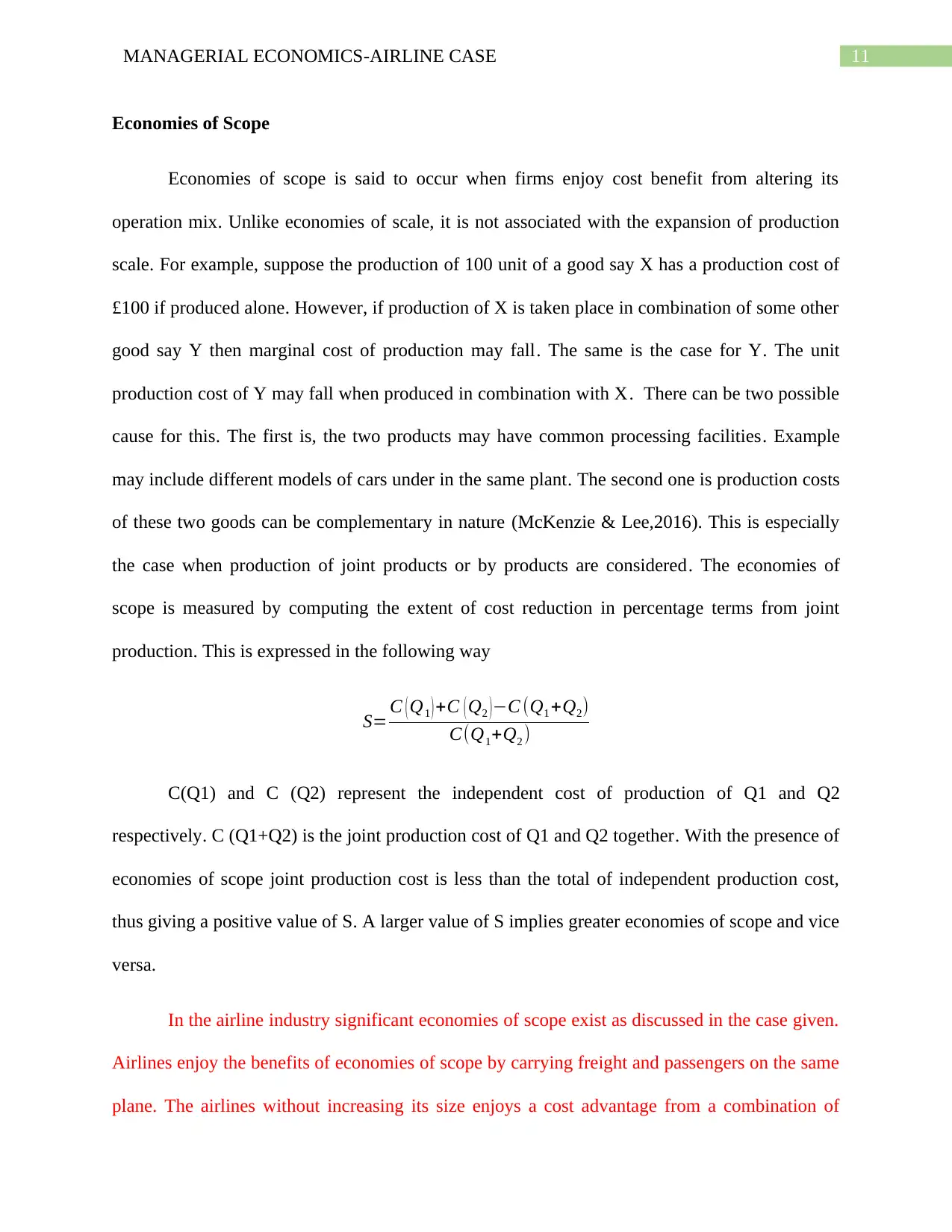
11MANAGERIAL ECONOMICS-AIRLINE CASE
Economies of Scope
Economies of scope is said to occur when firms enjoy cost benefit from altering its
operation mix. Unlike economies of scale, it is not associated with the expansion of production
scale. For example, suppose the production of 100 unit of a good say X has a production cost of
£100 if produced alone. However, if production of X is taken place in combination of some other
good say Y then marginal cost of production may fall. The same is the case for Y. The unit
production cost of Y may fall when produced in combination with X. There can be two possible
cause for this. The first is, the two products may have common processing facilities. Example
may include different models of cars under in the same plant. The second one is production costs
of these two goods can be complementary in nature (McKenzie & Lee,2016). This is especially
the case when production of joint products or by products are considered. The economies of
scope is measured by computing the extent of cost reduction in percentage terms from joint
production. This is expressed in the following way
S= C ( Q1 ) +C ( Q2 )−C (Q1 +Q2)
C(Q1+Q2 )
C(Q1) and C (Q2) represent the independent cost of production of Q1 and Q2
respectively. C (Q1+Q2) is the joint production cost of Q1 and Q2 together. With the presence of
economies of scope joint production cost is less than the total of independent production cost,
thus giving a positive value of S. A larger value of S implies greater economies of scope and vice
versa.
In the airline industry significant economies of scope exist as discussed in the case given.
Airlines enjoy the benefits of economies of scope by carrying freight and passengers on the same
plane. The airlines without increasing its size enjoys a cost advantage from a combination of
Economies of Scope
Economies of scope is said to occur when firms enjoy cost benefit from altering its
operation mix. Unlike economies of scale, it is not associated with the expansion of production
scale. For example, suppose the production of 100 unit of a good say X has a production cost of
£100 if produced alone. However, if production of X is taken place in combination of some other
good say Y then marginal cost of production may fall. The same is the case for Y. The unit
production cost of Y may fall when produced in combination with X. There can be two possible
cause for this. The first is, the two products may have common processing facilities. Example
may include different models of cars under in the same plant. The second one is production costs
of these two goods can be complementary in nature (McKenzie & Lee,2016). This is especially
the case when production of joint products or by products are considered. The economies of
scope is measured by computing the extent of cost reduction in percentage terms from joint
production. This is expressed in the following way
S= C ( Q1 ) +C ( Q2 )−C (Q1 +Q2)
C(Q1+Q2 )
C(Q1) and C (Q2) represent the independent cost of production of Q1 and Q2
respectively. C (Q1+Q2) is the joint production cost of Q1 and Q2 together. With the presence of
economies of scope joint production cost is less than the total of independent production cost,
thus giving a positive value of S. A larger value of S implies greater economies of scope and vice
versa.
In the airline industry significant economies of scope exist as discussed in the case given.
Airlines enjoy the benefits of economies of scope by carrying freight and passengers on the same
plane. The airlines without increasing its size enjoys a cost advantage from a combination of
⊘ This is a preview!⊘
Do you want full access?
Subscribe today to unlock all pages.

Trusted by 1+ million students worldwide
1 out of 19
Your All-in-One AI-Powered Toolkit for Academic Success.
+13062052269
info@desklib.com
Available 24*7 on WhatsApp / Email
![[object Object]](/_next/static/media/star-bottom.7253800d.svg)
Unlock your academic potential
Copyright © 2020–2025 A2Z Services. All Rights Reserved. Developed and managed by ZUCOL.